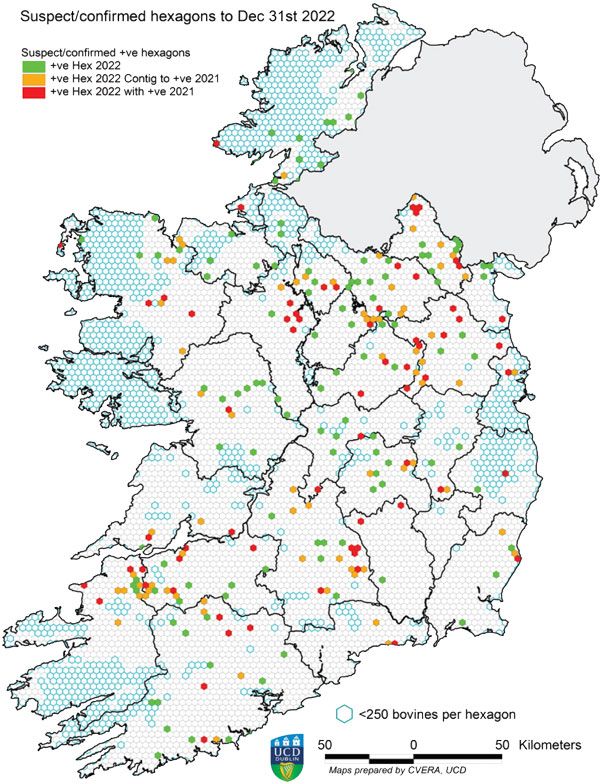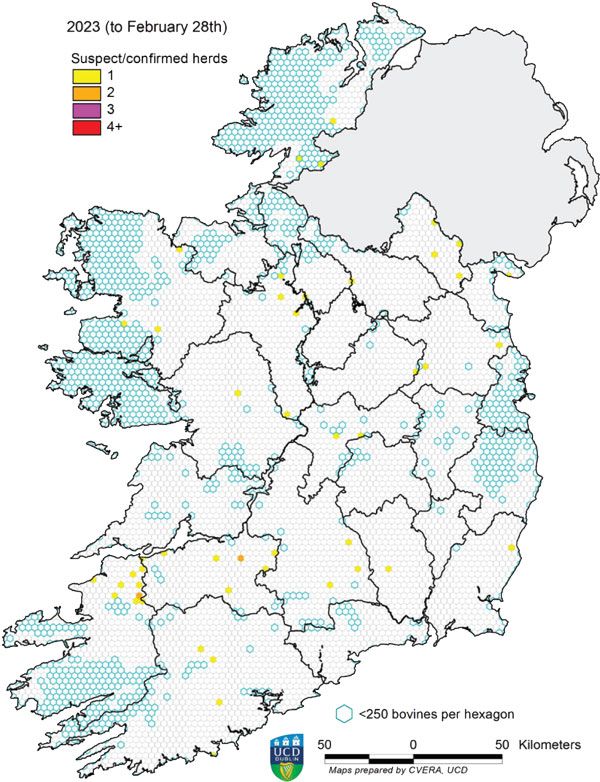Key aspects of biosecurity to prevent BVD infection pre-breeding
As we approach the last stages of the Irish BVD eradication programme, it is important that we are reminded of the most important risks for introduction of infection to negative herds, writes Maria Guelbenzu LV PhD MRCVS BVD Programme Manager, AHI. Although the current number of affected herds is small, the impact in these herds can be considerable, so it is critical to ensure that all possible measures are in place to prevent spread of infection
As a consequence of the highly seasonal calving pattern in Ireland, the majority of pregnant animals go through their window of susceptibility at a similar time, following the onset of breeding in April or May. For this reason, all herds are encouraged, in collaboration with their veterinary practitioner, to review their biosecurity practices before breeding commences to minimise the likelihood of pregnant cattle being exposed to BVD virus in the coming months. For herds that are currently BVD free, such exposure must necessarily come from outside the herd, through either direct or indirect contact with other cattle that are excreting the virus.
A recent study investigated the risk factors for detection of BVDV in low-risk herds during the latter stages of Ireland’s eradication programme (Casey-Bryars et al, 2022). The study population comprised herds that had calves born and tested negative for BVD virus (BVDV) every year from 2013 to 2019 (n =46,219 herds). Case herds were those which had one or more test positive calves for the first time in 2019 (n = 204 herds). Herd size, distance from herds with a positive result in previous years, and buying in potential trojan dams were key risk factors.
Larger herds may be at greater risk of exposure to BVDV through introduction of infection as a result of introduced cattle, shared boundaries with neighbouring farms, and location in proximity to other large herds in high cattle density areas. Herd size may also be associated with potential indirect BVDV transmission pathways such as visitors and equipment.
This article focuses on the distance from herds with a positive result in previous years and buying in potential trojan dams, as well as the risk from transiently infected animals and the collated results from the BVD-TASAH investigations carried out between 2016-2020.

Figure 1. Map showing the distribution births of BVD+ calves during 2022. Hexagons in green represent area with 2022 BVD+; hexagons in red represent areas with BVD+ in 2022 and 2021; hexagons in orange represent areas with BVD+ in 2022 that are contiguous to hexagons with BVD+ in 2021.
Distance from herds with a positive result in previous years
Contiguity with other herds with BVD virus positive (BVD+) results has been an identified risk within the Irish BVD programme by a range of studies (Graham et al, 2013, 2016; Barrett et al, 2020). More recently it has become clear that this effect is not just for herds where animals may have nose-to-nose contact with the neighbours’ cattle, but that there is a locality effect, and areas where we see cases one year will have a higher chance of having cases the following year.
We are now able to see this effect in our yearly maps. In Figure 1, each coloured hexagon represents an area of 10sq. km (approximately 1.8km radius) in which one or more BVD+ calves were detected in 2022. Those hexagons in red represent areas in which BVD+ results were also recorded in 2021. Those in orange represent areas with BVD+ in 2022 that are contiguous to hexagons with BVD+ in 2021, while those in green represent areas with 2022 BVD+ cases without either underlying or contiguous positive hexagons in 2021. Noticeable also are some clustering of positive hexagons, particularly on the Kerry/Limerick border. Figure 2 shows the distribution of herds with BVD+ results in 2023 up to February 23, with evidence of continued cases in this Kerry/Limerick cluster.
While effective biosecurity is important for all herds, particular care should be taken when dealing with herds within these coloured hexagons in Figures 1 and 2, as herds in these areas are at particular risk of having infection introduced in advance of the breeding season leading to the creation of further BVD+ calves to be born in 2024. Their biosecurity should be reviewed, including vaccination, and extra precautions should be taken by herd owners and visitors (both professional and otherwise) who should use farm-specific boots and clothing, or take steps to ensure that adequate cleaning and disinfection procedures are followed.

Figure 2. Map showing distribution of births of BVD+ calves during 2023 until February 28. Each hexagon represents an area of approximately 10sq. km.
Buying pregnant cattle
Where purchased cattle are pregnant, there is also the further risk that they may be trojan dams. Trojan animals typically occur when heifers or cows have been infected and are carrying a persistently infected (PI) foetus in one herd and which are then introduced to another herd.
Since 2021, herds with positive results are required to retain on their holding any females that were in calf at the time of disclosure of the positive result until their calf is born and BVD tested. However, trojans may also get infected in herds with no signs of infection. In the Irish BVD programme, around 70 per cent of herds that have had a birth of a BVD+ calf have a single case. And a further 20 per cent have only two BVD+ animals detected.
Trojan animals will be BVD seropositive and virus negative, but there are no laboratory tests to determine the status of the foetus, so the safest approach to protecting a herd is not to introduce pregnant animals. Pregnant animals being introduced following their return from contract rearing or other herds should be treated in the same way as purchased animals.
If pregnant animals are introduced, these should be calved in isolation and separated from other pregnant animals until their calves are tested negative.
Risk from transient infections
The programme enhancements introduced in 2021 allowed us to gain a better understanding of the risks from transient infections. One of the key programme changes was the sampling of the whole herd for virus at least three weeks after the removal of the last BVD-positive animal from the herd. This ‘circuit breaker’ was introduced to minimise the risk of detecting transient infections. By the end of the year 2021, 32 per cent of tested herds had at least one animal with a virus-positive blood sample at the whole herd test, with 1.2 per cent of all tested animals returning virus positive results. The majority of herds had a single blood-positive result, but in 12 herds there were 10 or more blood-positive animals. This highlights the extent and length of transient infection in a minority of affected herds and the need to apply good biosecurity when interacting with these herds (including when sampling for the whole herd test) to avoid accidental transmission of virus. In 2022, these figures improved with fewer than 21 per cent of tested herds having at least one blood positive animal, and one per cent of all tested animals returning virus positive results.
BVD TASAH results
Based on the outcomes of 4,105 BVD TASAH investigations by trained veterinary practitioners between 2016 and 2020 (Guelbenzu-Gonzalo et al, 2021), the following were identified as the most likely pathways by which infection was introduced to pregnant cattle during the window of susceptibility and should therefore be the focus of biosecurity reviews. While carried out with BVD in mind, attention to these areas will reduce the likelihood of introducing infectious diseases in general.
Boundary contact. Wherever possible, cattle up to 120 days of pregnancy should not graze at boundaries where nose-to-nose contact with other cattle is feasible. Boundaries should be sufficient to provide a gap of at least 3m and prevent cattle breaking in or out (even if only on a temporary basis using an electric fence).
Purchased cattle (or those returning from sales, shows or contract rearing), especially those that are already pregnant. While the movement of BVD virus positive animals is prohibited by legislation, it is possible that purchased cattle could come in contact with BVD virus immediately prior to, or during, the process of being sold or transported. This is particularly the case where animals from different herds are in contact and the purchasing farm’s own transport is not being used. Exposure under these circumstances will lead to the cattle being transiently infected (TI) with BVD virus. While TI cattle will only excrete virus for a short time, if they come in immediate contact with cattle in early pregnancy then there is a risk of creating PIs. Therefore, purchased cattle should be held in a quarantine facility (building or paddock) for at least 28 days, with particular care taken to avoid them coming in contact with pregnant stock.
As mentioned above, where purchased cattle are pregnant, there is also the further risk that they may be carrying a BVD virus positive calf. It is important that their calves are tested promptly and kept away from other pregnant animals until tested negative. The use of hired, leased or borrowed bulls also poses a potential risk.
Movement of personnel without adequate attention to hygiene. All individuals coming onto a farm, including employees, relief workers, professional visitors (vet, AI, milk recorder, hoof trimmer etc) and the herd owner pose a potential risk. In the absence of any control measures, this risk increases in proportion to the number of other herds that the individual has had contact with previously, and the closeness of contact with cattle in those herds. Therefore, only essential personnel should contact cattle, particularly in early pregnancy, and all personnel, including the farmer, should use farm-specific boots and clothing or take steps to ensure that adequate cleaning and disinfection procedures are followed where there is a risk of contamination. It is best practice to keep a record of all farm visitors.
Equipment. Movement or sharing of large items (e.g., trailers) or small items (e.g., nose tongs, dehorners) of equipment should be avoided where possible. Otherwise, these should be thoroughly cleaned and disinfected before use.
Vaccination. While vaccination will not prevent the entry of BVD virus onto a farm, it can minimise the impact of accidental introduction. Discuss with herd owners potential changes to their vaccination policy and their herd’s biosecurity. Note that, once Ireland is recognised as BVD-free, BVD vaccination will have to stop.
Key actions for herd owners
Tissue tag-test calves as soon as possible after birth. Where positive or inconclusive results are obtained, these calves should be removed promptly to obtain the higher level of financial support provided by DAFM and to end herd restrictions as soon as possible.
Test animals of unknown status to obtain Negative Herd Status (NHS). The presence of animals that either have not produced a negative calf or which do not have a valid result recorded on the database prevents herds attaining NHS and accessing lower cost testing. Since April 1, 2020, there is a legal requirement to test pre-2013-born animals.
All farmers, especially those within the coloured hexagons in Figures 1 and 2, should review biosecurity, including any potential changes to their vaccination policy, to avoid accidental reintroduction of infection.
In summary, taking care with biosecurity at farm boundaries and with visitors and equipment entering the farm, as well as avoidance, or careful risk assessment, of purchasing cattle (particularly potentially pregnant animals), will contribute to the prevention of introduction of BVDV.
- Barrett, D., Clegg, T., McGrath, G., Guelbenzu, M., O’Sullivan, P., More, S. J., et al (2020). Herd-level factors associated with detection of calves persistently infected with bovine viral diarrhoea virus (BVDV) in Irish cattle herds with negative herd status (NHS) during 2017. Prev Vet Med 179, 104990. doi: 10.1016/j.prevetmed.2020.104990.
- Casey-Bryars, M., Tratalos, J. A., Graham, D. A., Guelbenzu-Gonzalo, M. P., Barrett, D., O’Grady, L., et al (2022). Risk factors for detection of bovine viral diarrhoea virus in low-risk herds during the latter stages of Ireland’s eradication programme. Prev Vet Med 201, 105607. doi: 10.1016/J.PREVETMED.2022.105607.
- Graham, D. A., Clegg, T. A., Lynch, M., and More, S. J. (2013). Herd-level factors associated with the presence of bovine viral diarrhoea virus in herds participating in the voluntary phase of the Irish national eradication programme. Prev Vet Med 112, 99–108. doi: 10.1016/j.prevetmed.2013.07.011.
- Graham, D. A., Clegg, T. A., Thulke, H. H., O’Sullivan, P., McGrath, G., and More, S. J. (2016). Quantifying the risk of spread of bovine viral diarrhoea virus (BVDV) between contiguous herds in Ireland. Prev Vet Med 126, 30–38. doi: 10.1016/j.prevetmed.2016.01.017.
- Guelbenzu-Gonzalo, M. P., Lozano, J. M., O’Sullivan, P., Lane, E. A., and Graham, D. A. (2021). A herd investigation tool in support of the Irish BVD eradication programme. Front Vet Sci 17. doi: 10.3389/fvets.2021.694774.
1. Which of the following statements is correct:
A. Contiguity with herds with BVD+ results has been highlighted as a risk by various studies
B. Programme maps can be used to assess the locality risk
C. Increased biosecurity should be applied in all areas but especially in those with current or previous BVD+ cases
D. All of the above
2. The risk factors for herds with no previous history where BVD emerged in 2019 for the first time were:
A. Increasing herd size, sharing equipment and neighbouring a positive herd
B. Increasing herd size, the purchase of trojan dams and geographical proximity to an infected herd
C. Herd size, animal movements and sharing equipment
D. Herd size, purchasing animals and neighbouring a positive herd
3. Which of the following statements is correct regarding trojan animals:
A. Since 2021, herds with positive results are not to sell any females that were in calf at the time of disclosure of the positive result until its calf is born and BVD tested
B. Not all trojan dams originate in herds that have had evidence of concurrent infection
C. Pregnant animals being introduced following their return from contract rearing or other herds should be treated in the same way as purchased animals
D. All of the above
4. Which of the following statements is not true:
A. Herds will be able to continue vaccinating for BVD after obtaining EU-recognised freedom
B. Herds with a history of BVD are more likely to experience a re-emergence event
C. Proximity to an infected herd has been shown to be associated with a herd becoming positive in the following year
D. If pregnant animals are introduced, these should be calved in isolation and separated from other pregnant animals until the calves are tested negative
Answers: 1D; 2B; 3D; 4A.















